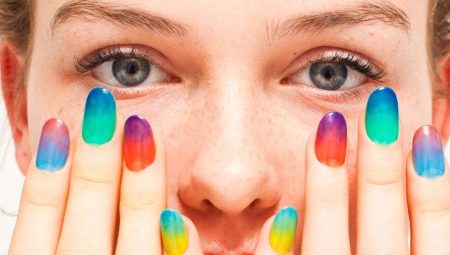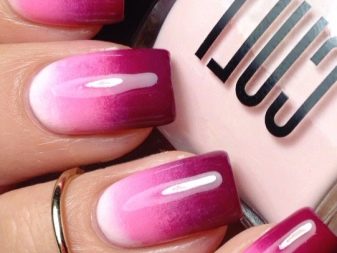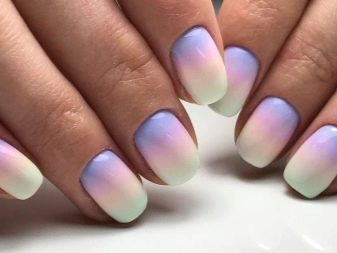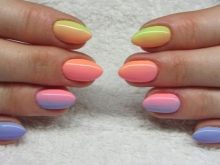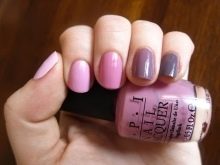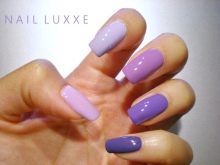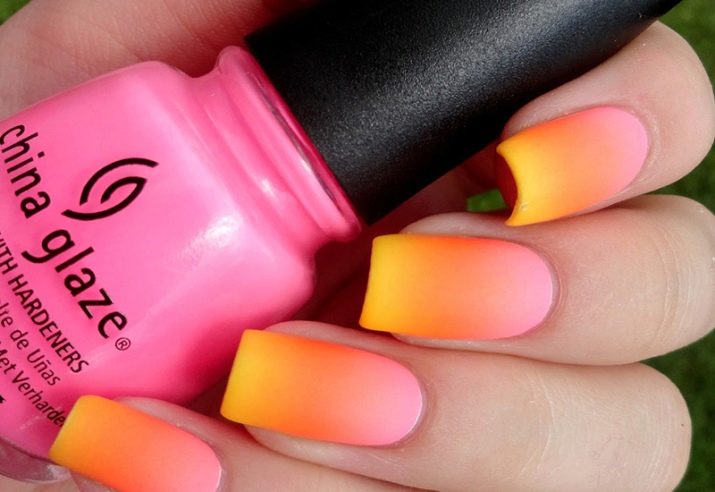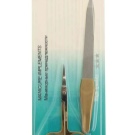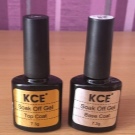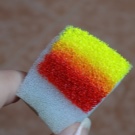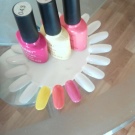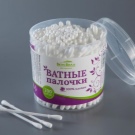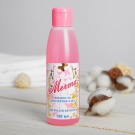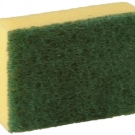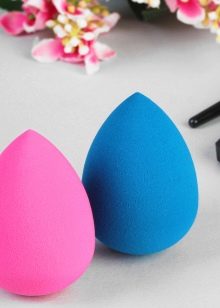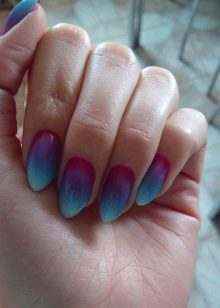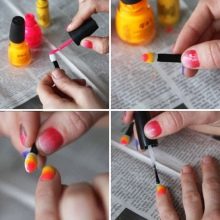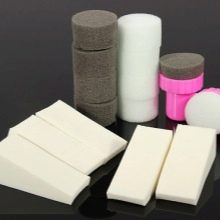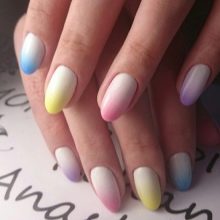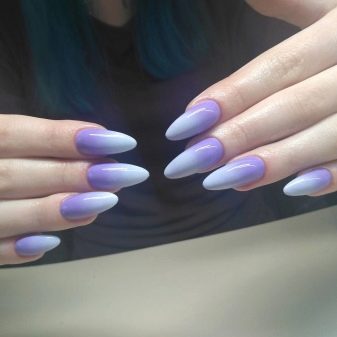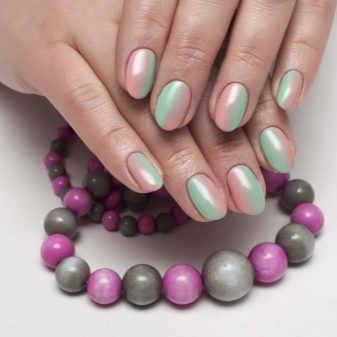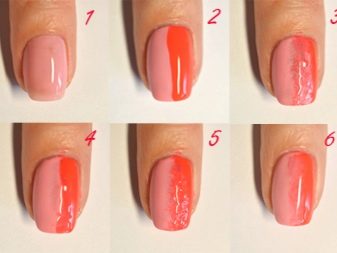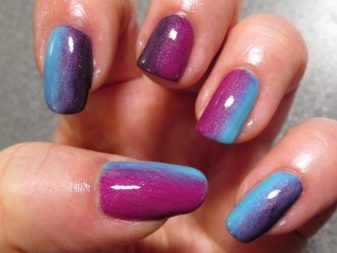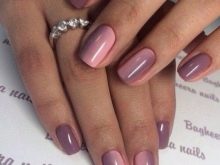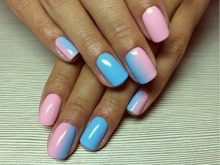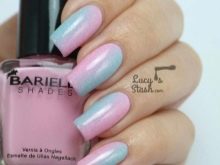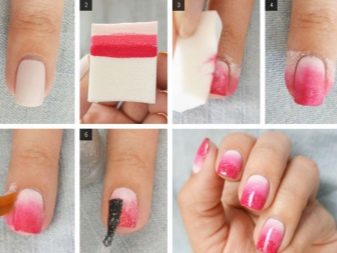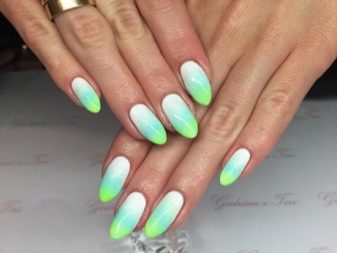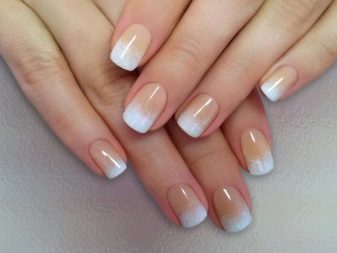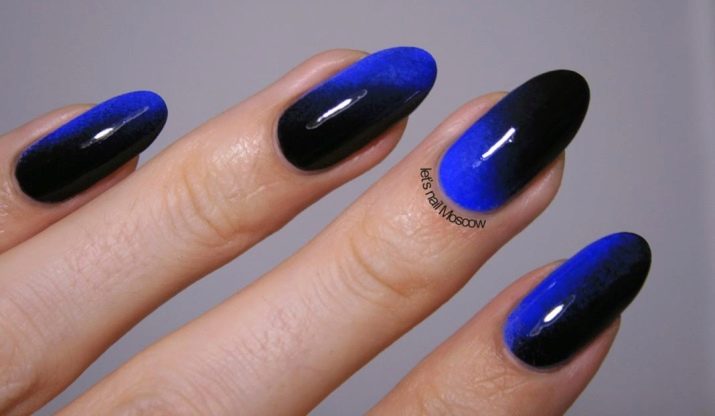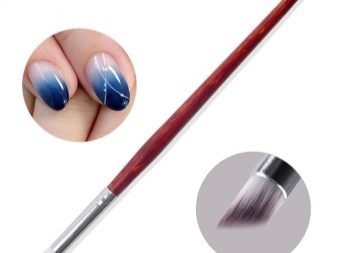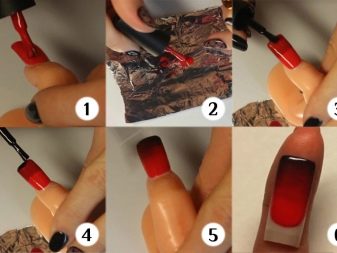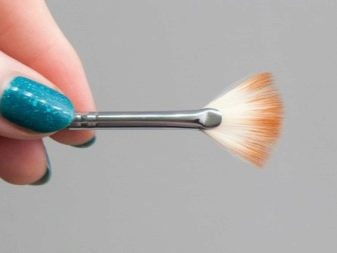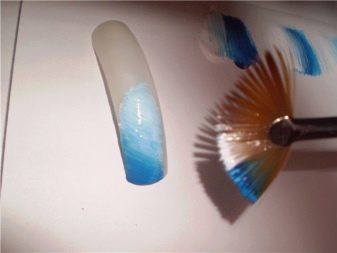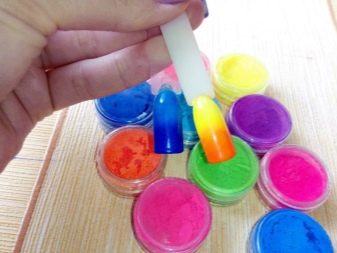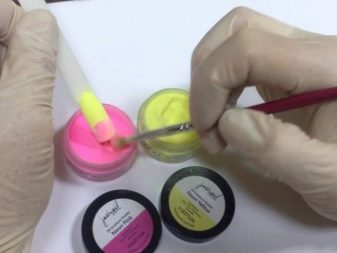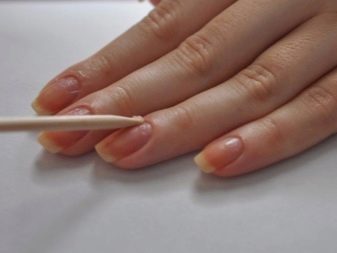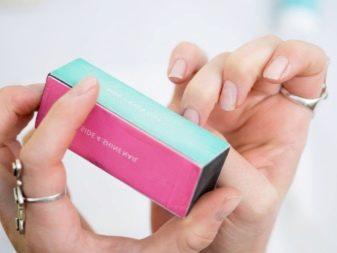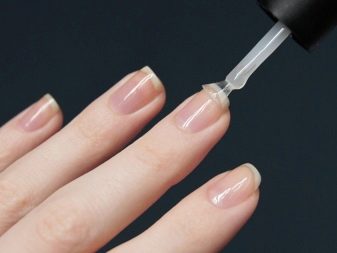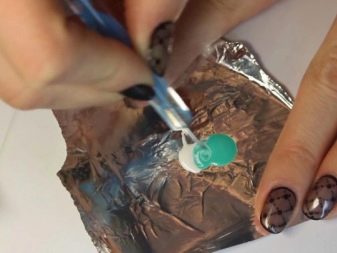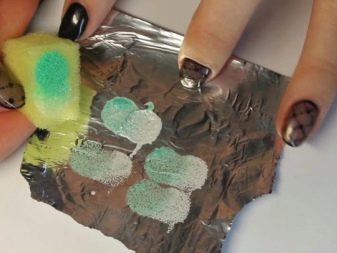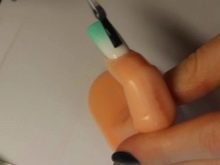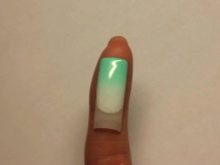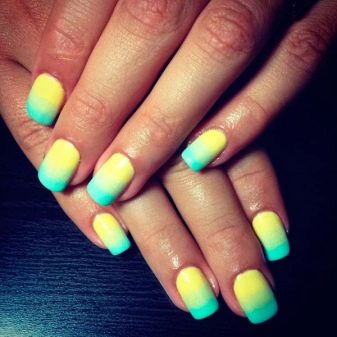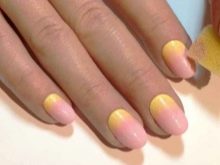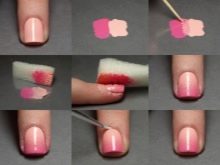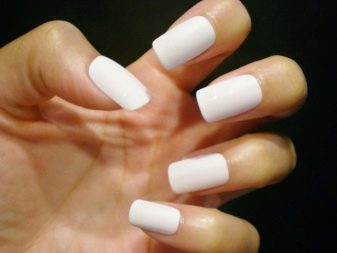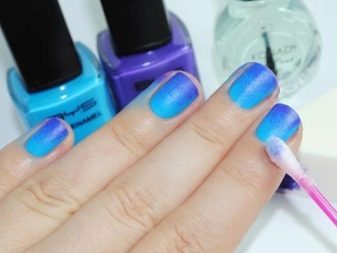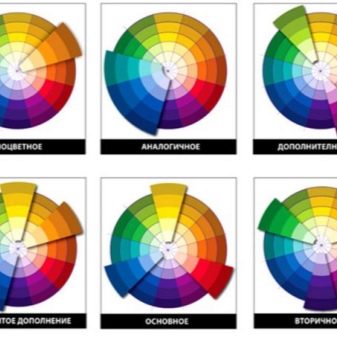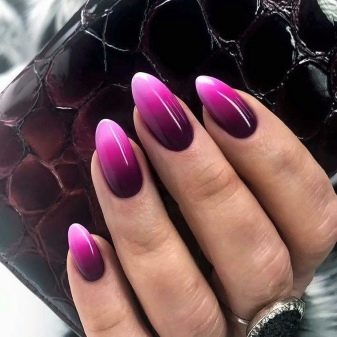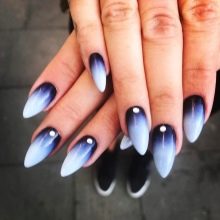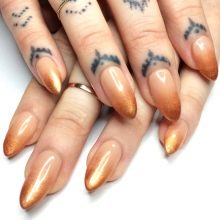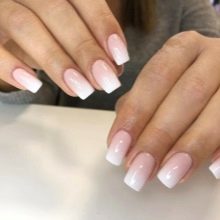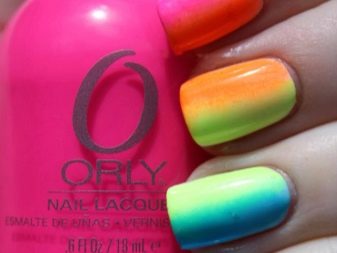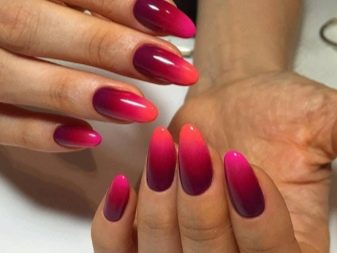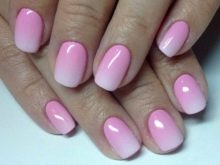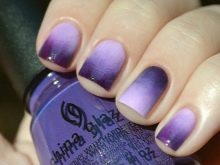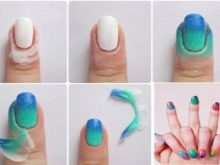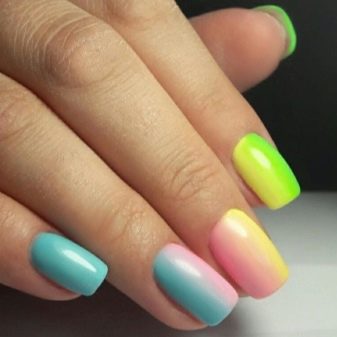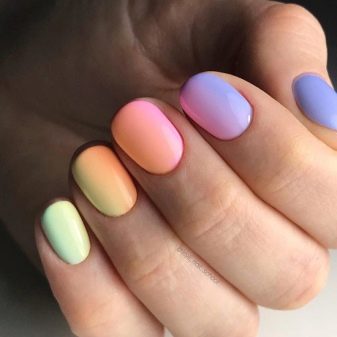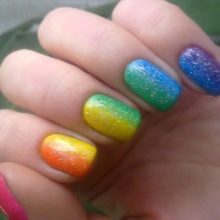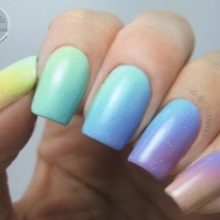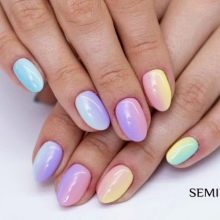Ombre is considered one of the most attractive manicure styles, otherwise referred to as gradient or stretching. His distinguishing feature is the unhurried transition of color from light to dark. As a rule, this “movement” comes from the hole, that is, the base is varnished in pastel shades, and the tip is already saturated dark. The best way is the transition of colors of a single color range, for example, from pale pink to rich cherry. A special kind of gradient called stretching over the entire arm. In this case, the thumb is painted in one shade, the little finger in the other, and intermediate colors are formed between them.
Necessary tools and materials
In order to create an ombre on your nails, you will need traditional tools for processing, for example, a nail file and scissors, a special base and a transparent glossy fixer, a foam sponge, several varnishes, white paper or foil, as well as cotton buds and a coating remover. Lucky can be ordinary or gel polishes. Palette options include items such as a piece of plastic, a saucer, a plastic lid, or a disposable plate. Instead of a special sponge, by the way, you can take a regular dishwashing dish and then cut it into several pieces.
Since after using it you still have to throw it away, this solution will be doubly economical.
Of course, the kitchen sponge has its drawbacks. Due to the cellular structure of the material itself, a slightly uneven transition of shades is formed, as if covered with grains. To smooth it it turns out, several times pressing a sponge to a nail, but in this case in a varnish coat small air bubbles turn out. Therefore, it is better to purchase an expensive sponge of latex used for applying foundation. It is equally elastic, like a kitchen sponge, but it has much smaller pores. As a result, the layers blend harmoniously without the appearance of bubbles, and the final gradient differs naturally.
It is better not to take cheap latex sponges, as they are too soft and are not able to print a gradient. Moreover, they absorb excess lacquer and even disintegrate during operation. The simplest variation of an ombre can be created with the help of foam rubber applicators used for applying shadows. Of course, experts have already invented specialized sponges. The first variation looks like an elongated triangle of foamed latex, and the second one looks like a round sponge of fine foam rubber attached to a plastic base.
Effect Techniques
Experts identify three main techniques to create an ombre that can be modified and adjusted to the desired design. By the way, the smoothness of the transition, as well as the number of lacquers used depends on the desire of the master or customer.
Vertical
In the vertical ombre, the transition is from one edge of the nail to the other from left to right. As a rule, the varnish is applied with a flat brush, and the transition is formed when using a sponge or shadow applicator. The coating of one color is applied on one half, the other on the other, and then the border is blurred.
Horizontal
Horizontal ombre implies smooth and calm transverse transitions from the cuticle to the nail edge.They can be created using two colors or more.
The gradient is created with the help of three varnishes applied against the palette.
Diagonal
In the case of a diagonal ombre, the flow of colors, as the name suggests, occurs diagonally.
In addition to the above, there are three ways to design an ombre using a brush.
- In the first case, a flat tool with an elastic bristle and a lint-free cloth is taken. Coating strips are applied to the nail plate, which are practically in contact with each other. Then the brush is lowered into the nail polish remover and gently blurs the border. As a rule, the procedure is repeated several times to create at least three layers with bright colors.
- In the second case, a fan brush is required. First, the entire nail is painted with the first varnish, and this color will have to remain on the cuticle. Then an intermediate shade is painted over the middle of the plate, and the tip is painted with a second lacquer. The fan brush is slightly moistened, and then the transitions are blurred with it.
- Finally, produce an ombre with acrylic powder. In this case, powder is immediately applied to the painted nail, with its help the borders between shades are shaded.
How to make a manicure with a gradient at home?
At home it is quite possible to make an ombre correctly if you follow the instructions step by step. First of all, the nails are processed as with any other kind of manicure. The nail plate is given the desired shape, around the hole with an orange stick the cuticle is removed, the surface is polished and, if necessary, the skin of the hands is nourished with cream. In addition, the nail will have to be degreased with a nail polish remover and covered with a base that will not only perform a protective function, but also provide a quality coupling with a color coating. A thick white sheet or foil will be used as a palette.
Parallel stripes are drawn on it with selected varnishes, which only barely touch each other. It is important to arrange it so that the ombre is then formed, which means it is necessary to think of a harmoniously looking sequence. The sponge is lowered onto the palette so that it captures all the colors, and then is transferred onto the nail, being pressed against it several times with light slaps. By the way, for each nail plate will have to create a separate blank. When all the nails are dry, you will need to remove all the excess with a cotton swab, and then fix the finished manicure with a transparent fixative.
The top not only smoothes a rather rough surface, but also blurs the border between tones, dissolving them a little.
There is another common ombre variation that is performed with contrasting shades. For such a manicure will have to choose two opposite, but nevertheless combined colors. It can be blue and orange, yellow and lilac or bright red and light green. First, the marigolds are prepared according to the usual scheme, including the base applied. Then the color is applied to the nail, which is to “complete” the plate, that is, to be on its tip. When it dries, a second color is applied with a sponge or sponge, covering the plate from the base to the middle. On top of everything is fixed colorless varnish.
In general, there are the following ways to apply a gradient:
- first one varnish is painted, and then the second is applied with a sponge;
- a palette is used with two strips of selected colors, the borders of which are mixed using a toothpick; colors can be as many as you want; an ombra is created with a sponge dipping at once into all available colors;
- strips are applied immediately to the sponge and immediately transferred to the nail plate; This method is well suited for quick-drying varnishes.
Important! Many experts recommend creating an additional base of white color.It will make other used paints brighter, but you have to spend enough effort to hide the substrate. The side zones and the cuticle zone will need to be further processed with a brush or tweezers with a miniature fragment of the sponge.
Secrets of the perfect cover
To make an ombre, you need to try to avoid common mistakes. First of all, we are talking about accuracy - only in this case, this type of manicure looks beautiful. Then, on your own, it is not always possible to choose a harmonious combination of colors, it is better to consult with a specialist or to find a ready-made scheme on the Internet. In the case when you still want to choose the colors yourself, you should choose several shades of the same color, for example, from beige to coffee, or look at the color circle and give preference to the neighboring tones. Contrasting shades can be combined only in the presence of an intermediate tone, creating a transition zone. Ombre is not combined with sparkles and strazikami, in this case, the effect of bad taste and redundancy most often occurs.
Finally, an ombra cannot be attributed to universal designs, so it is still not advisable to do it on the eve of an important business meeting.
Ombre is suitable for nails of any size and shape. By the way, after the gradient coloring the plate becomes visually narrower, and the fingers become more graceful. However, it should be remembered that for such a manicure you should not choose coverage of different textures. This means that mother of pearl is combined only with mother of pearl, and cream lacquers - with cream. To avoid bubbles, you need to either gently press the sponge, or slightly moisten it with water, or make the first prints on paper to get rid of excess varnish. Protect the skin around the nail plate will succeed with the help of PVA glue. Prior to dyeing, it will need to be spread on a finger, and then wait until it dries. Upon completion, the film will leave right along with the varnish. Used for this purpose film face masks, tape, as well as special tools designed to protect the cuticle.
Beautiful examples
The ombre called “Five Fingers” is considered to be very beautiful and quite simple in execution. First, the nail plate of the thumb is covered in the first color. Next on the palette gently mixed by a drop of the first and second varnish, and the resulting color is applied to the index finger. Following on the palette mix one drop of the first, but already two drops of the second varnish. This shade will be used for the middle finger. A drop of the first and three drops of the second lacquer are useful for the ring finger. Finally, the little finger will be painted in the second selected color.
In the next video, see 6 ways to make a gradient on the nails.
